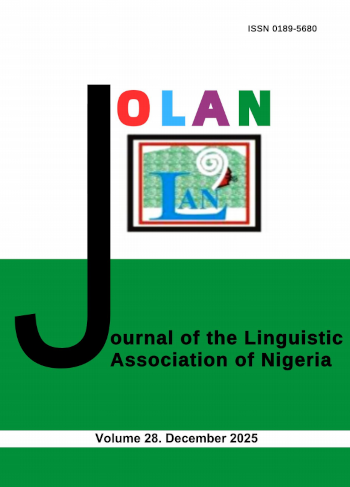Teacher-induced error: The case of language students of University of Nigeria, Nsukka
Keywords:
Error analysis, transfer of training, intralingual errors, interlingual errors, induced errorsAbstract
Mother tongue (MT) interference, intralingual and developmental errors are seen as the basic causes and classifications of errors by error analysts. One other cause of error is the errors of inducement. This paper looks at an aspect of induced errors ‘teacher-induced errors’. The paper investigates the influence of the teacher’s pronunciation of choice words that have homophonous or have near homophonous tendencies on the spellings of Linguistics students of the University of Nigeria, Nsukka. Dictation tests were administered twice in a classroom environment. 80 students, 20 students each from the four levels of study constitute the sample size for the study. Sets of sentences were read out to the students by their teacher to test: if the pronunciation of words by the teacher influences the spelling abilities of the students even when the words are contextualized; to know if it is an inherent spelling challenge of individual students and then to establish Stenson’s (1974) view on the existence of induced errors as a cause and classification of error. The paper realized that the teacher-induced pronunciation is one of the causes of errors to be looked into in the spellings of the students. Individual student’s competence in spelling is seen to play a big role in the spelling errors committed by the students. Again, the degree of exposure of the learner to the L2, judging by the level of study of the students, prove to be a stronger point for less responses of the 4th level students to teacher-induced pronunciation errors.
References
AbiSamra, N. (2003). An Analysis of Errors in Arabic Speakers’ English Writings. American University of Beirut. http://abisamra03.tripod.com/nada/languageacq-erroranalysis.html Assessed 3-12-16.
Burt, M. & Kiparsky, C. (1974). Global and local mistakes. In J. Schumann and N. Stentson (Eds.) New frontiers in second language learning. Rowley, Massachusetts: Newbury House Publishing Inc.
CARLA Center for Advanced Research on Language Acquisition (2016). Overview of error analysis. University of Minnesoto. www.carla.umn.edu/learnerlanguage/error_analysishtml assessed 3-12-16.
Choroleeva, K. (n.d). Language transfer: Types of linguistic errors committed by francophones learning English as a second foreign language. Retrieved on www.hltmag.co.uk/oct09/mart02.rt. Assessed on 3-12-16.
Corder, S. P. (1974). Error analysis. In J. P. B. Allen and S. P. Corder (Eds.) Techniques in applied linguistics (Edinburgh course in applied linguistics 3). London: Oxford University press. 122-154.
Corder, S. P. (1967). The significanc.e of learners’ errors. In J. C. Richards (Ed.) Error analysis: perspectives on second language acquisition. London: Longman. 19-27.
Dinter, A. (2004). Induced errors - sources and pedagogical deductions. Munich: GRIN Verlag
Fries, C. (1945). Teaching and learning English as a foreign language. Ann Arbor: University of Michigan Press.
Gefen, R. (1979). The analysis of pupils’ errors. English teachers Journal, 22 16-24.
James, C. (1998). Errors in language learning and use: Exploring error analysis. London: Longman.
Kim, D. H. (2009). A study on the use of lexical collocations of Korea heritage learners: identifying the sources of errors. A thesis of the University of Southern California.
Lado, R. (1957). Linguistics across cultures. Ann Arbor: University of Michigan Press.
Richards, J. C. (1971). A non-contrastive approach to error analysis. English Language Teaching Journal, 25, 204-219.
Schachter, J. & Celce Murcia, M. (1977). Some rem-vations conceining error analysis. TESOL Quarterly 1, 11(4), 441 -451.
Selinker, L. (1972). Interlanguage. International Review of Applied Linguistics (IRAL), 10 (3), 209-231.
Selinker, L. (1969). Interlanguage. IRAL, 3, 114-132.
Sompong, M. (2014). Error analysis. Thammasat Review, 16(2), 109-127.
Stenson, N. (1983). Induced errors. In B.W. Robinett & J. Schachter (eds), Second language learning: Contrastive analysis, error analysis and related aspects. (pp. 256-71). Ann Arbor: University of Michigan Press.
Stenson N. (1974). Induced errors. In J. Schumman and N. Stenson (Eds.) New frontiers in second language learning. Rowley, Massachusetts: Newbury House Publishing Inc.
Touchie, H. Y. (1986). Second language learning errors their types, causes and treatement. Jalt Journal, 8, (1) 75-80.
UKEssays (2015). Source of errors in language learning research English language essay. Assessed 3-12-16. Wikipedia, the free encyclopedia (2016). Error analysis (linguistics). http://en.wikipedia/wiki/Error_analysis_(linguistics) assessed 3-12-16.














